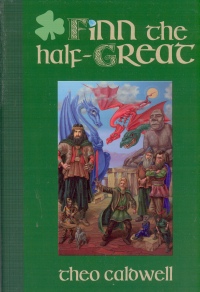| ________________
CM . . .
. Volume XVI Number 19. . . .January 22, 2010 
 |
Finn the Half-Great
Theo Caldwell.
Toronto, ON: Tundra Books, 2009.
382 pp., hardcover, $24.99.
ISBN 978-0-88776-931-3.
Grades 4-8 / Ages 9-14.
Review by Janet M. Johnson.
** /4
|
| |
|

excerpt:
She knelt at the edge of the seal and brushed the dust off with her palm. At once it glowed a brilliant gold, so bright that she had to shield her eyes yet for a moment. Then she busied herself with both hands, wiping away the film of centuries.
When she was finished, the room seemed to be filled with sunlight, as if her dusting had moved it from night to day. She put her hands on her hips and scrutinized the magnificent seal. A Dragon was in the centre, its wings spread in majestic flight. Its ruby eyes flashed with fearless wisdom. In its claws was an unfurled scroll on which were written two words – "Numen Lumen." The dragon soared over two rounded diamonds and the seal was ringed with bold letters spelling words Oonagh knew and longed for – "Immortal until Proven Otherwise."
"Immortal until Proven Otherwise" we learn is the motto of the old giants of the Earth who lived to fight, lived very long lives and enjoyed brave deaths when their time came. Over time, we learn, they dispersed over the earth, with some coming to settle in Ireland. However, the fiercest giants, the Fomorians, were driven out of Ireland to settle in the North lands ,and under their chief they become the enemies of their Irish enemies and Finn's father. Over time, the Irish giants married human women and had children although the wives did not survive childbirth. Our hero, Finn was the offspring of such a marriage.
Irish mythology is violent, and, in its true form, much of it is all about revenge. While there will always be children who read mythology and the exploits of epic heroes, Irish mythology is not very well known outside of Ireland, and the problem with this book is that many of the allusions will only be known to people of Celtic origins. Caldwell has a website about the book and Finn which explains all the allusions to mythology chapter by chapter. Natural wonders that exist now, such as the Giant's Causeway, a feat of building by the half giant, Finn, in the book are explained.
Other problems with the book are with the tone and dialect that the author uses. The Irish tone, or lilt, pervades the book, and a reader with an average vocabulary might lose patience with such embroidered language as these phrases, "mortal imps," "scant talk," "king's cackles" and "unfurled scroll."
Furthermore, many readers may find the author's use of the third person as narrator a stumbling block for easy identification with Finn. Suspension of disbelief is an art, and this book fails in that respect. Young readers will feel that they are learning the history of Irish mythology instead of escaping into a fantasy world. Finn MacCool, the hero, is less interesting than his companions.
The plot flows quickly, but the book could really be divided into two quest adventures without any damage to the sense of each story, and the resulting two shorter novels might have been less tedious to read. Although fantasy readers enjoy imaginative worlds and multi-part series of books, this story, set in Ireland, is limited in geographic space.
When the story begins, the reader is thrust into the history of Finn's parentage and how his father died at the hands of the Ice Giant Ymir, a character who is taken from Norwegian mythology according to Caldwell's website. Finn, a true Irish mythological hero, sets off with this knowledge to revenge the death of his father and the tragic widowhood of his mother. This is the first quest story in the book. The second tale is Finn's quest, after a long period of complacent marital happiness, for his wife, Oonagh, who was kidnapped in a battle between humans and the remnants of the older race of giants and their descendants. The humans, or mortals, want to take over Ireland for their own uses and to kill all the large giants of legends and bring in a new order.
Unless the reader has a background in reading myths and legends and an interest in Irish culture, they will find it as tedious as I did. Caldwell has created a story with a fine mythic hero in Finn, the half Great, unfortunately, the book attempts to explain Irish mythology to children with the same literary style as Mary and Charles Lamb's Tales of Shakespeare, and it will have a limited appeal.
Recommended.
Janet M. Johnson is a librarian and instructor at Red River College in Winnipeg, MB.

To comment
on this title or this review, send mail to cm@umanitoba.ca.
Copyright © the Manitoba Library Association. Reproduction for personal
use is permitted only if this copyright notice is maintained. Any
other reproduction is prohibited without permission.
NEXT REVIEW |
TABLE OF CONTENTS FOR THIS ISSUE
- January 22, 2010.
AUTHORS |
TITLES |
MEDIA REVIEWS |
PROFILES |
BACK ISSUES |
SEARCH |
CMARCHIVE |
HOME |
